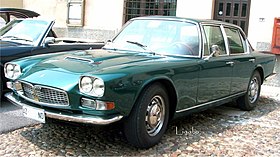
Maserati Quattroporte I 1963–1969

| Quattroporte I (AM107, 1963–1969) | |
|---|---|
 |
|
| Overview | |
| Production | 1963–1969 |
| Assembly | Modena, Italy |
| Designer | Pietro Frua |
| Body and chassis | |
| Layout | Front-engine, rear-wheel-drive |
| Related | Maserati Mexico |
| Powertrain | |
| Engine | 4.1 L V8 4.7 L V8 |
| Transmission | 5-speed ZF S5 manual 3-speed Borg Warner automatic |
| Dimensions | |
| Wheelbase | 2,750 mm (108.3 in) |
| Length | 5,000 mm (196.9 in) |
| Width | 1,720 mm (67.7 in) |
| Height | 1,360 mm (53.5 in) |
| Kerb weight | 1,757 kg (3,874 lb) |
The Maserati Quattroporte (Italian pronunciation: [ˌkwattroˈpɔrte]) is a four-door sports luxury saloon produced by Italian car manufacturer Maserati.
The name translated from Italian literally means "four doors". There have been six generations of this car, with the first introduced in 1963, and the current model launched in 2013.
The original Maserati Quattroporte (Tipo AM107) was built between 1963 and 1969. It was a large saloon car powered by V8 engines—both firsts for a series production Maserati.
History

The task of styling the Quattroporte was given to Turinese coachbuilder Pietro Frua, who drew inspiration from a special Maserati 5000 GT (chassis number 103.060) he had designed in 1962 for Prince Karim Aga Khan. While the design was by Frua, body construction was carried out by Vignale.
Series I (1963–1966)
The Quattroporte was introduced at the October-November 1963 Turin Motor Show, where a pre-production prototype was on the Maserati stand next to the Mistral coupé. Regular production began in 1964. The Tipo 107 Quattroporte joined two other grand tourers, the Facel Vega and the Lagonda Rapide, capable of traveling at 200 km/h (124 mph) on the new motorways in Europe. It was equipped with a 4.1-litre (4,136 cc or 252 cu in) V8 engine, producing 260 hp (194 kW; 264 PS) DIN at 5,000 rpm, and either a five-speed ZF manual transmission or a three-speed Borg Warner automatic on request. Maserati claimed a top speed of 230 km/h (143 mph). The car was also exported to the United States, where federal regulations mandated twin round headlamps in place of the single rectangular ones found on European models.
Between 1963 and 1966, 230 units were made.
Series II (1966–1969)
In 1966, Maserati revised the Tipo 107, adding the twin headlights already used on the U.S. model. A leaf-sprung solid axle took place of the previous De Dion tube. The interior was completely redesigned, including the dashboard which now had a full width wood-trimmed fascia. In 1968 alongside the 4.1-litre a 4.7-litre version became also available (AM107/4700), developing 290 PS (213 kW; 286 hp) DIN. Top speed increased to a claimed 255 km/h (158 mph), making the Quattroporte 4700 the fastest four-door saloon in the world at the time.
Around 500 of the second series were made, for a total of 776 Tipo 107 Quattroportes. Production ended in 1969.
Specifications

The first generation Quattroporte had a steel unibody structure, complemented by a front subframe. Front suspension was independent, with coil springs and hydraulic dampers. Rear suspension used a coil sprung De Dion tube featuring inboard brakes on the first series, later changed to a more conventional Salisbury leaf sprung solid axle with a single trailing link on the second series. On both axles there were anti-roll bars. Brakes were solid Girling discs all around. A limited slip differential was optional.
Engines
The long lived quad cam, all-aluminium Maserati V8 engine made its début on the Quattroporte. It featured two chain-driven overhead camshafts per bank, 32 angled valves, hemispherical combustion chambers, insterted cast iron wet cylinder liners, and was fed through an aluminium, water-cooled inlet manifold by four downdraught twin-choke Weber carburettors—initially 38 DCNL 5 and 40 DCNL 5 on 4200 and 4700 cars respectively, later changed to 40 DCNF 5 and 42 DCNF 5 starting from December 1968.
| Model | Engine | Peak power | Peak torque | Top speed |
|---|---|---|---|---|
| Quattroporte 4200 | 4,136 cc (252 cu in) 90° DOHC V8 |
260 PS (191 kW; 256 hp) at 5500 rpm | 370 N·m (273 lb·ft) at 3500 rpm | 230 km/h (143 mph) |
| Quattroporte 4700 | 4,719 cc (288 cu in) 90° DOHC V8 |
290 PS (213 kW; 286 hp) at 5200 rpm | 410 N·m (302 lb·ft) at 3500 rpm | 255 km/h (158 mph) |
Special models 1971 and 1974

In 1971, Karim Aga Khan ordered another special on the Maserati Indy platform. Rory Brown was the chief engineer. It received the 4.9-litre V8 engine (Tipo 107/49), producing 300 PS (221 kW).Carrozzeria Frua designed the car, the prototype of which was displayed in Paris 1971 and Geneva 1972. The car was production ready, even receiving its own chassis code (AM 121), but Citroën used their influence to have Maserati develop the SM-based Quattroporte II instead. Only two vehicles were finished, chassis #004 was sold by Maserati to the Aga Khan in 1974, and the prototype #002 went to the King of Spain, who bought his directly from Frua.
